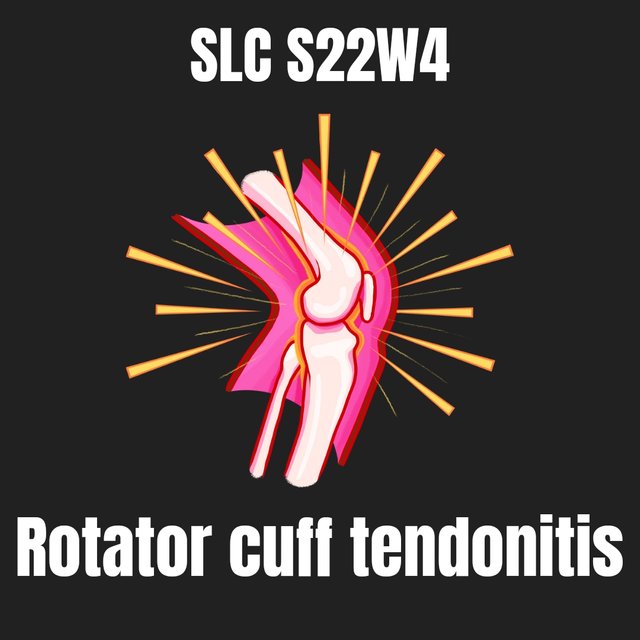Steemit Learning Challenge-S22W4; Rotator Cuff Tendonitis"

If I talk about rotator cuff tendonitis then this is inflammation of tendons which is surrounding joint of shoulder and specially rotator cuffs.Rotator cuff are group of muscles and tendons which are providing stability and movement to shoulder.
Stages and types
If I talk about types of rotator cuff tendonitis then these are below;
• If I talk about supraspinatus tendonitis then it causes inflammation of supraspinatus tendon.infraspinatus tendonitis causes inflammation of infraspinatus,Teres minor tendonitis cause inflammation of teres minor tendon, suprascapularis tendonitis causes inflammation of supraspinatus tendon.
• If I talk about first stage then this is mild in which swelling and irritation of tendon occurs due to repetitive strain.
• If I talk about second stage then this is moderate in which clicking and snapping sound can be heard because of degeneration of tendon and it lead to pain and stiffness.
• If I talk about 3rd stage then this is severe in which complete or partial rupture of tendon may occur and surgical intervention is required in this stage.
Symptoms
• Aching or burning pain in shoulder.
• Stiffness and restricted movement in shoulder joint.
• Weakness in shoulder muscles and lifting, rotating arm difficulty.
• Swelling and redness at shoulder (Affected area).
Causes
• Overuse and repetitive strain at shoulder.
• Hunched and slouched posture put strain at muscles.
• Blow and fall at shoulder directly.
• Tendon wear and tear because of aging.
• Participating in those activities in which there are excessive involvement of overhead activity.
Treatment
• Icing for inflammation reduction and NSAID for pain.
• Physical therapy interventions in mild to moderate case.
• Surgical intervention in severe case.
History taking and assessment
• If I talk about first step then this is about taking history from patient about present and past medical history which will be helpful for knowing any injury if it has been occurred and symptoms of patient.
• If I talk about assessment then this is second step in which patient symptoms severity and duration will be monitored and assessed!
Physical examination
• If I talk about first step of physical examination then this is inspection in which doctor will check for signs of redness,inflammation etc.
• If I talk about second step then this is about palpating for checking tenderness that is it present or not.
• If I talk about third step then this is about checking for range of motion of shoulder.
Special tests
• If I talk about first step then this is Neer test in which doctor will elevate arm of patient in forward flexion and will stabilize scapula so in case of pain and restricted mobility test will be positive.
• If I talk about second step then this is empty can test which is used for evaluating supraspinatus tendonitis in which doctor will hold arm of patient in 30 degree of flexion and 90 degree of abduction and thumb will be in download direction so if pain is increasing then test is positive.
• If I talk about Hawkins canady test then it is used for evaluation of subacromial impingement and tendonitis of rotator cuff. In this test doctor will hold arm of patient in 90 degree of forward flexion and arm internal rotation. If patient pain will increase then test will be positive!
Imaging tests
• Magnetic resonance imaging will be more appropriate imaging test because it will confirm rotator cuff tendonitis diagnosis by assessing extent of tendon damage.
• Ultrasound is also helpful for checking thickness and vascularity of tendon.
• X-ray is important to rule out if there is any fracture of bone present but it's not actually for tendonitis evaluation and diagnosis.
Cross body shoulder stretch
https://youtube.com/shorts/L-rBJ3jniU0?si=2Cwzrr7oHMlLKjK5
Scapular squeeze
https://youtube.com/shorts/pxF1cJAtRIE?si=UUD-FZUaExltIhJt
https://youtube.com/shorts/mVCCQXwQ17s?si=iebPnXVlNBsiqOmk
Shoulder isometrics
I performed cross body shoulder stretch, shoulder isometrics and scapular squeeze from which I really like cross body shoulder stretch because it helped me a lot in improving elasticity of my muscles and it lengthen my muscles which was shortened ,because of stretch.
I also feel improvement in my muscles strength of shoulder after performing shoulder isometrics! Scapular squeeze was also easy and effective for me!
I want to invite @mile16,@joojoo78,@steemdoctor1
Hi! Your post is great and contains a lot of valuable information about this condition, it's amazing how our shoulder can be so affected by multiple causes, poor thing ;( we must take great care of the shoulder joint.
Have a nice day!
Thank you for understanding the lesson and sharing your assignment; I hope that you will enjoy this week's lesson and try to implement it in your life if you see any such case.
Observations
Task 1 (2.8/3)
You have shared a great knowledge about rotator cuff tendonitis, its symptoms, causes and it's stages. But you didn't add the name of muscles around the shoulder, that's good you added the tendons name. I appreciate your effort.
Task 2 (3/3)
In the second question, you tell us about how you have to assess a patient by doing physical examination, history taking, and investigations. That's good you add special tests and also explanation of both special tests and investigations. Excellent.
Task 3 (4/4)
You try the cross body shoulder stretch, shoulder isometric and scapula squeeze. You did the cross body shoulder stretch, shoulder isometric and scapula squeeze correctly. Always remember to apply heat pack in chronic condition and ice pack in acute condition before performing exercises to relax the muscles and reduce stiffness. I appreciate your efforts.
Overall you made a great attempt to answer all the questions. I appreciate your efforts. But next time try to avoid the above written suggestions. Keep learning and try to implement your knowledge to the people suffering from rotator cuff tendonitis or any type of shoulder issue. Thank you.